Abstract
Playability is an attribute that refers to the ability to stimulate individual responses or collective action in an immersive activity in an exploratory way. Playability is an important component of the enjoyment and well-being of urban dwellers, has the potential to stimulate urban vitality and is an important expression of the inclusiveness and equity of urban space. The pursuit of economic development and efficiency-oriented urban construction has led to the domination of urban space by overcrowded traffic, economy-oriented commerce and densely populated housing. Moreover, the existence of playable space has become a scarce resource and is seen as a site for the materialisation of social rights. As the haze of the COVID-19 pandemic fades and cities are again exposed to wider and more participatory use, determining how to adapt urban spaces to the playability needs of users of different ages, cultural backgrounds and social classes, and provide them with appropriate site use and experience, is becoming a hot issue of concern for building equitable and high-quality urban spaces. The study of the playability of urban spaces is highly complex, and the related research on social justice is cryptic. In order to better investigate the social equity aspects of urban playability, this paper integrates scientometric and manual methods to review the relevant research. This paper takes 2664 related papers from the Web of Science (WOS) core dataset from 1998 to 2022 as the research object and employs CiteSpace to organise the existing research results of playful urban spaces. Quantitative analysis is used to clarify the theoretical foundations, developments and research hotspots of urban spatial playability, while the manual collation and generalisation of the studies uncover the hidden issues of social justice research. Based on the proposed research method, we summarize the key three research stages related to urban spatial playability and social equity. We also discuss the development of urban spatial playability in the perspective of social justice from three aspects: micro, meso and macro. The results can help readers better understand the current status and development process of research on playful urban space. In particular, we clarify the issues related to social justice under the theme of the playability of urban spaces and provide directions for future research on building playful cities and promoting the development of urban socio-spatial equity.
1. Introduction
Contemporary cities are highly interconnected, densely populated and socially active. The public remains connected in the city by engaging in reciprocal practices such as socialising and recreation [1]. Spaces within cities that have the capacity to hold immersive activities that inspire individual responses or collective action in an exploratory way are considered to have the property of urban spatial playability [2]. Jane Jacobs, in her book The Death and Life of Great American Cities, emphasise s that “casual social interaction” creates public trust, which increases activity, experience and enjoyment [3]. The “playable city” is a broader concept that can often be understood as “a vision of the city that makes space for play, entertainment and games as a fundamental goal of urban design” [4].
What is social justice? Additionally, what are the key research topics on social justice in the field of urban space research? Before discussing social justice and playability, we need to unpack social justice and social-spatial justice. The specific substantive concept of social justice in social life can be understood as showing which differences and similarities between individuals are essential for the definition of basic obligations and rights, and how the balance of competing demands is legitimate and desirable [5]. In urban spaces, social-spatial justice often refers to the fairness of people’s access to spatial resources, in which certain spatial resources of a public nature become the focus of social justice research [6]. Social justice in urban space focuses mainly on health equity for disadvantaged groups, equity of access to public services (e.g., as green spaces) and the imbalance between jobs and housing for low-income groups. The sub-themes of social justice in urban space are rich and diverse and include age equity, gender equity, race equity, class equity, etc. By examining urban space under different sub-themes, we can classify socio-spatial justice into quantitative equity, qualitative equity and distance equity. Quantity equity refers to whether the quantity of spatial resources of different demand types in the same area or of the same demand type in different areas meets the demand and whether it is fair; quality equity refers to whether a type of space can meet the demand of different types of users or whether it can maintain the rights and interests of different users; and distance equity refers to whether the distance of different residential areas from the same type of resources within a certain range is fair. This sub-theme of social justice and social-spatial justice are appropriately combined, thus extending to many research topics.
The playability of space is often ignored by designers and planners in the process of urban construction. The current social equity issues of urban spatial playability are mainly reflected in the three aspects. (1) Equity in the quality of play spaces: There is an inequality in the supply and demand for play spaces in a single type of urban space, and the existing play spaces do not meet the play needs of all people. Numerous studies focus on playability for children, but research on the needs of other age groups is limited. (2) Equity in the distance of play spaces: different types of play spaces are not equally accessible in a given area, and some homes are too far away from high-quality play spaces. (3) Equity in quantity of play spaces: play spaces are unevenly distributed across the geographical area, with some relatively deprived areas suffering from a lack of play spaces in congested streets. The experience and perception of playfulness attracts a large number of urban residents to a more interesting, participatory and cohesive environment. Thus, developing and researching playfulness at the level of equity is critical to creating more playful cities.
Playability is a vague term, which is often used but rarely clearly defined. It is adopted by game researchers, gamers and industry practitioners alike, and its conceptual origins are more diverse due to interpretations and definitions from different perspectives. The concept is most widely used in the field of video game evaluation. Paavllalnen explicitly explored a game-centric definition of playability based on the functionality, usability and gameplay of a game [7]. In the field of habitat-related living, the development of the concept of playability can be traced back to the late 1990s, with several urban planning theories elaborating the importance of recreation in urban life (Lefebvre’s Right to the City concept) [8]. An example of the intersection of the two fields includes electronic fantasy games (such as SIM City) that visualize the future of the city and include concepts of spatial playability. Manzoni et al. provided a comprehensive overview of the concept of playability from this point of view and propose that playability is the degree to which a player can learn, control and understand the game [9]. This was followed by the gradual emergence of the theme of the playable city, which represents a general macro-level vision of the city. The playable city is a complex theme that encompasses a wide range of disciplines, including urban design and planning, urbanism and architecture, human–computer interaction and urban computing, as well as game design and other behavioural design fields [10]. According to the author’s survey, there is no clear definition or scope of research on playable and playful cities but there is a slight progressive trend on the extent to which the goals of playable and playful cities are achieved; namely, the playable city is an academic goal and the playful city is an imaginative goal. In order to better evaluate playability in research, the concept of the playability of urban space has been developed. Similarly to the playable city, the development of the definition of playability is complex. The playability of urban space was first developed by KaBOOM! and the behavioural economics research institute IDEAS42 and was formally presented at the 2015 US Playable City Leaders Summit in Chicago [11]. As the meaning and scope of the playable city continues to expand, the playability of urban spaces has evolved from describing the playful attributes of space used by groups of children to a new term that quantifies the richness of urban spaces and their livability.
Previous studies have summarised playful urban spaces from different perspectives based on for example, statistics on the implementation of playful urban design [12], playful spatial elements [13], and playful city politics [14]. However, there is a lack of a systematic collation of playful urban space research from the perspective of social justice, thus preventing the comprehensive understanding of the overall state of playful urban space research and its branches.
This can be attributed to the very broad and unclear characteristics of social justice, and the keyword “playability” itself can denote the fighting of social justice issues. Many authors do not mention the keyword “social justice” in their articles, and some authors do not even realise that they are addressing social justice issues. In order to better explore social justice in urban play spaces. The research steps for this article include the following: (1) Use the Web of Science (WOS) analysis function to organise and summarise the published research on urban spatial playability. (2) Use Citespace for the scientometric analysis of the overall playability situation. In particular, the research situation and the cooperation network of national and research institutions in the field of urban spatial playability research is organised, allowing readers to keep abreast of the general state of urban playability studies around the world. Furthermore, keyword co-occurrence and cluster analyses are used to study the research hotspots in the field of urban spatial playability. Lastly, keyword salience analysis is adopted to investigate the evolution of research themes in urban spatial playability from the perspective of social justice. (3) Discuss in detail the specific research content and development direction of urban spatial playability in terms of social justice via manual collation. This paper presents for the first time the use of CiteSpace to analyse and visualise the playability of urban spaces. The results can help practitioners in related industries to have a better understanding of urban space playability from a macro perspective, clarify new research frontiers in related fields and provide important support for future work.
2. Methods and Data Sources
2.1. Data Collection
The Web of Science Core Collection database contains the most prestigious and influential journals and has long been regarded as the most authoritative and scientific source of data [15]. It contains the majority of publications on built environment research, with a sufficient amount of data. Given the high coverage of WOS and its compatibility with CiteSpace software [16], it was chosen as the primary data source for this paper. Based on the core collection of the Web of Science (WOS) database, this study focuses on the two themes of ‘playability’ and ‘urban space’. The search terms (Table 1) were finalised based on previous research by scholars and repeated attempts by the author. In terms of word choice, the inclusion of the search term ‘social equity’ resulted in just 34 articles. The reason for this is two-fold: (1) Social equity is more often studied in other subject areas and has a weaker relationship with urban space; (2) sub-topics are more relevant, but they are cryptic and broad in nature, and it is not possible to collate keywords that fully cover all possibilities. Therefore, the terms related to social justice were not included in the search terms, and only the syntax of ‘playability’ AND ‘urban space was used. For the selection of words related to ‘playability’, the common descriptive words ‘playable’ and ‘playful’ were used, as well as the common noun ‘playability’ and the verb ‘play’. For the choice of words for urban space, the nouns of the first level of the macro noun ‘city’ were chosen to encompass a wider range of spatial types, followed by the second level of macro nouns contained in city: ‘built environment’; ‘public space’; ‘urban street’; ‘urban space’; and ‘street space, street’. At this point, the meso or micro nouns ‘playground’ and ‘green space’ are already included, and, thus, they are not retrieved. In order to cover all research results, ‘all’ was selected as the entry time, and an initial search yielded 12,484 articles. The research covered in this review included dissertations, conference proceedings, review articles, online publications, editorial materials and book reviews, while less researched article types such as art exhibition reviews, theatre reviews and dance performance reviews were excluded. The downloaded article data were selected as complete records, with the basic data of each article including authors, title, abstract, keywords and references. In order to ensure that all research results were covered, ‘all’ was selected as the entry time. Following a rough search and the removal of duplicates or low relevance literature, a total of 2664 records were obtained as the data source for this study. The search was performed on 22 December 2022.

Table 1.
Topics and terms used for the search in this paper.
2.2. Research Method
The data processing was performed using Citespace (version 6.1.R6), a knowledge visualisation tool for scholarly mapping that excels at visualising bibliographic records and mapping knowledge. The tool was developed in 2004 by Professor Chao-Mei Chen of Drexel University, USA [17]. Citespace is based on co-citation theory and path-finding algorithms that enable the multivariate, time-dependent and dynamic citation analysis of domain-specific material for Java-based networks, bibliometrics and domain-specific literature to explore critical paths and knowledge inflection points in the evolution of subject areas [18]. Citespace can be used to predict trends in a discipline or field of research with a high degree of objectivity and credibility [19] and to explore the frontiers and hot topics in research [20].
In this paper, Citespace was employed to perform the scientometric analysis of research on playable urban spaces in order to capture the corresponding research status, research collaboration, research lineage and research development.
3. Results
3.1. Analysis of Literature Volume
A total of 2664 papers were analysed using the tools included in the WOS database to obtain a graph of the annual changes in the literature. The results reveal that from 1998 to 2016, the research entered its initial phase, with a steady increase in the number of papers (Figure 1). The first paper was published in 1998 and focused on the influence of the built environment on children’s play behaviour and, in particular, on the relationship between the greening of outdoor spaces and the incidence of children’s creative play [21]. In 2017, the number of articles exploded, peaking in 2019. Despite the decline after 2019, the overall enthusiasm for research did not diminish. In general, the number of articles published from 1998 to 2022 was observed to increase on a yearly basis, reaching a stable level of more than 200 in the last 5 years. Although the number of current published studies on the playability of urban spaces has fluctuated, the general growth trend is stable, indicating that interest in this topic has always remained at a relatively stable level.
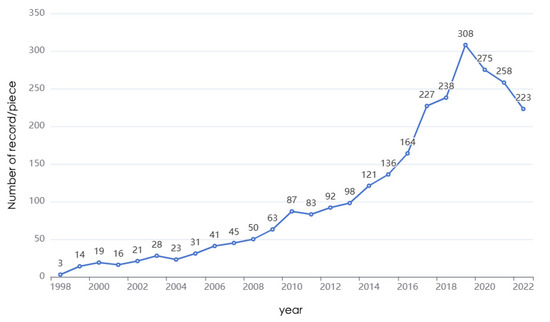
Figure 1.
Annual change in the amount of published literature from 1998 to 2022.
3.2. Analysis of Scientific Cooperation
3.2.1. Regional Distribution
The national distribution and international cooperation in the field of playable urban space were determined by performing a country co-occurrence map analysis on the data (Figure 2). The overall country co-occurrence map reveals that the nodes are closely connected, the research topic is widely studied globally and the collaboration between countries is strong. In terms of the number of articles published (Table 2), the United States (USA) has the largest number of articles with 679 articles, accounting for 25.49% of the total number of articles published, followed by the United Kingdom (n = 300, 11.26%), China (n = 214, 8.03%), Canada (n = 155, 5.82%), Australia (n = 149, 5.59%), etc. (Table 2). Figure 2 reveals that research on playable urban spaces began in North America and the United Kingdom (UK). The centrality of each node reflects the influence of the object in the whole field, and the higher the centrality, the more influential the object is in a certain period of time [22]. The USA, the UK, Canada and Australia are coloured purple on the outside of the corresponding nodes in Figure 2, reflecting their high mediating centrality. The USA has the highest degree of centrality (centrality = 0.42) and plays a key mediating role in the cooperative network, thus exerting the greatest influence in this field of research compared to the other countries. The centrality of China is 0.05, indicating a weak degree of influence from Chinese research at present and a low cooperation with other countries.
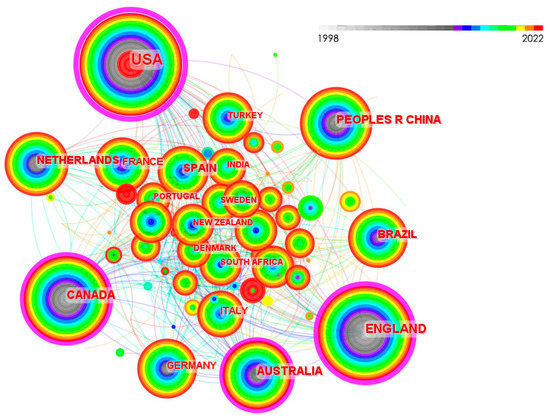
Figure 2.
Visualization map of urban playability research by country for the period 1998–2022.

Table 2.
Top five countries in terms of number of publications 1998–2022.
3.2.2. Research Institutions
CiteSpace was employed to analyse the institutional collaboration of research on playable urban spaces in order to map institutional collaboration. A total of 585 institutions conducted research on urban playability and collaborated with each other 558 times during the study period. The top 10 research institutions in terms of the number of published papers were exported and reviewed (Table 3 and Figure 3).

Table 3.
Top 10 institutions by number of articles published for the period 1998–2022.
In terms of the number of publications, Columbia University ranked first with 25 (n = 25, 0.94%), followed by UCL (n = 24, 0.90%) and the University of Melbourne (n = 24, 0.90%). The most productive institutions are mainly located in the USA, UK, Australia, Canada, the Netherlands and Brazil. Columbia University, UCL and Delft University of Technology each form a research circle, led by the aforementioned countries, with the University of Melbourne, Deakin University, the University of Sao Paulo, the University of Western Australia, and the University of Alberta; the University of Toronto; and the University of Utrecht, respectively.
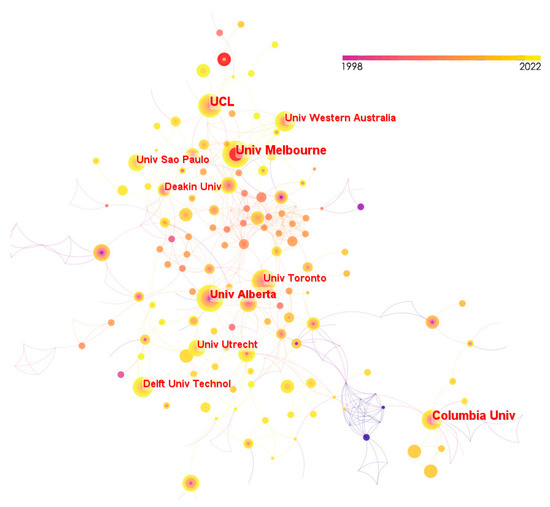
Figure 3.
Cooperative network of urban playability research institutions for the period 1998–2022.
3.2.3. Author Collaboration Network
Author collaboration analysis provides insight into the level of interest and intensity of collaboration among scholars in a given research area. The author collaboration map was derived from the analysis of playable urban space research data. The mapping reveals 706 nodes, with node size indicating the frequency of each author’s posts and 526 links reflecting collaborations (Figure 4, Figure 5 and Figure 6). The authors with the most posts include Karen Witten (n = 7, New Zealand), Mark S. Tremblay (n = 6, CANADA), J. Aaron Hipp (n = 6, USA), Peter T. Katzmarzyk (n = 5, USA), Alberico Claudia (n = 5, USA), and Tyler Prochnow (n = 5, USA). The analysis focuses on the three main research groups.
The first major research group is the Massey University and Akron University of Technology Collaborative Research Group, led by Karen Witten (Figure 4). The focus of this research group is quality equity in urban playable spaces. The main sub-topic of interest is age equity in children. This group focuses on the play rights of vulnerable urban children and, in particular, on urban spaces that enhance children’s play in New Zealand. Examples include the following investigating how the urban neighbourhood environment affects children’s ability to move independently and, consequently, how often they participate in daily tasks and physical activity [23]; assessing indoor and outdoor play spaces for children in inner-city apartments [24].
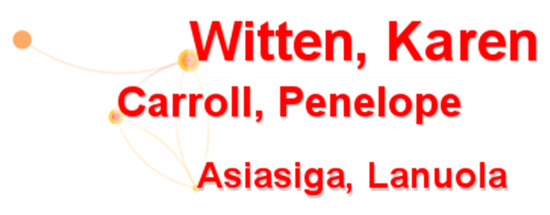
Figure 4.
Collaborative network 1 of authors for urban playability research for the period 1998–2022.
The second largest research group is that of Mark S. Tremblay, Peter T. Katzmarzyk, Vincent O. Onywera and others (Figure 5). The study group also focuses on the quality equity of play in the city. An important health purpose of playfulness is to increase physical activity. This research group has conducted a number of studies to determine how to make neighbourhoods more playful and how to improve the quality of playability of spaces in relation to the built environment and the promotion of physical activity. Examples include the relationship between infrastructure and children’s physical health [25] and the relevance of neighbourhood environmental characteristics to physical activity for community transport and recreation [26].
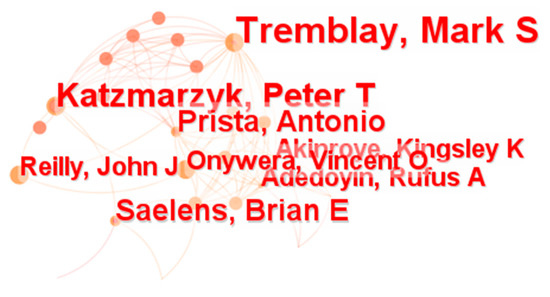
Figure 5.
Collaborative network 2 of authors for urban playability research for the period 1998–2022.
The third major research group is the NC State University research group, consisting of J. Aaron Hipp, Jing-Huei Huang, Dustin Fry, Myron F. Floyd, Claduia Alberico, Oriol Marquet, Gina S. Lovasi and Elizabeth Mazak (Figure 6). This research group is also concerned with quality equity in the environment, with the main sub-theme of interest being income equity. The relevant research is primarily related to park use in low-income communities, including how neighbourhood characteristics encourage and discourage children’s use of parks [27] and park usage by low-income minority children [28].
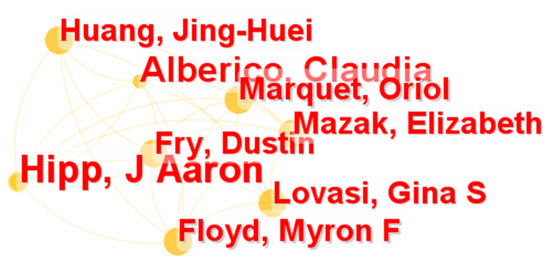
Figure 6.
Collaborative network 3 of authors for urban playability research for the period 1998–2022.
3.3. Research Focus and Academic Groupings
3.3.1. Research Focus
Figure 7 depicts the graph derived from the keyword co-occurrence analysis using CiteSpace. The size of the nodes represents the occurrence frequency of the keyword in the domain. The plot contains 667 keywords and 3600 connecting lines.
Based on the number of keyword occurrences (Table 4), the keywords with high frequency were determined as city/built environment/environment/public space/space/geography (617), physical activity/health/obesity/walking (515), children/school/youth/adolescents (339), play/behavior (196), smart city (61) and politics (58).
The top 20 keywords appear before 2015, setting the tone for the current field of research as a whole. Research topics mainly include (1) the built environment, with the aim of increasing physical activity and improving physical health; (2) the design of child- or youth-friendly urban spaces in relation to the walking and playing behaviour of children or young people; and (3) the integration of digital interaction in cities, the application of virtual reality in real-life and the creation of smart cities. We have compiled a list of keywords that have been cited more than 10 times in the last 3 years, including gender (n = 13, 2020) and environmental justice (n = 10, 2020).
Based on the previous playability research, playability is now often seen as a way to improve physical vitality and health. Moreover, the population of playability in urban spaces is typically identified as the youth population. In addition to playing, walking is also a form of play, and playability can be derived from both real and virtual entities. In the social equity perspective, quality equity is the main object of study, while the age equity of children is the most popular social equity sub-topic. By analysing keywords with more than 10 mentions in the last 3 years, the issue of social justice is revealed to have moved from the hidden to the visible.

Table 4.
Keywords of the top 20 keywords of urban playability research in terms of frequency.
Table 4.
Keywords of the top 20 keywords of urban playability research in terms of frequency.
| No. | Freq | Centrality | Label | Year | No. | Freq | Centrality | Label | Year |
|---|---|---|---|---|---|---|---|---|---|
| 1 | 243 | 0.03 | physical activity | 1999 | 11 | 67 | 0.04 | adolescent | 2001 |
| 2 | 194 | 0.1 | city | 2005 | 12 | 67 | 0.02 | association | 2011 |
| 3 | 166 | 0.04 | built environment | 2014 | 13 | 66 | 0.02 | obesity | 2007 |
| 4 | 147 | 0.08 | health | 2003 | 14 | 63 | 0.05 | behavior | 1999 |
| 5 | 138 | 0.15 | children | 2016 | 15 | 61 | 0.01 | smart city | 2015 |
| 6 | 133 | 0.04 | play | 2017 | 16 | 59 | 0.02 | walking | 2008 |
| 7 | 78 | 0.04 | school | 2009 | 17 | 58 | 0.03 | politics | 2011 |
| 8 | 76 | 0.06 | environment | 2017 | 18 | 58 | 0.03 | space | 2003 |
| 9 | 71 | 0.01 | public space | 2010 | 19 | 56 | 0.04 | youth | 2009 |
| 10 | 68 | 0.02 | perception | 2014 | 20 | 52 | 0.03 | geography | 2008 |
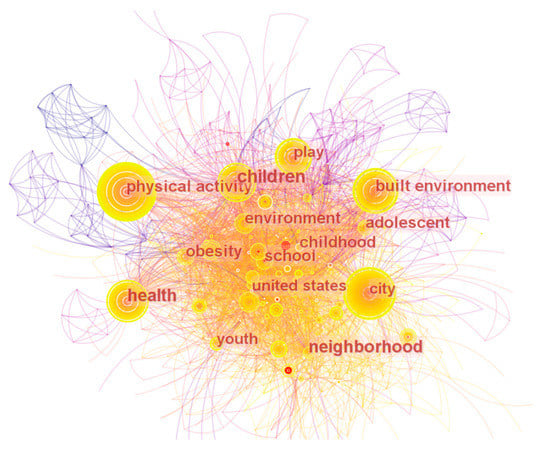
Figure 7.
Co-occurrence graph of keywords for urban playability research for the period 1998–2022.
3.3.2. Academic Groupings
The clustering analysis of playable urban space studies was performed using CiteSpace’s standard LLR algorithm to extract the cluster labels (Figure 8 and Figure 9). The clusters are divided into nine prominent research clusters based on their keywords. The modularity (Q = 0.3822 > 0.3) indicates that the clustering structure is significant, while the silhouette (S = 0.736 > 0.7) reveals the stable structure and sufficient confidence of the clusters. The nine identified clusters (Table 5) are described in more detail below.
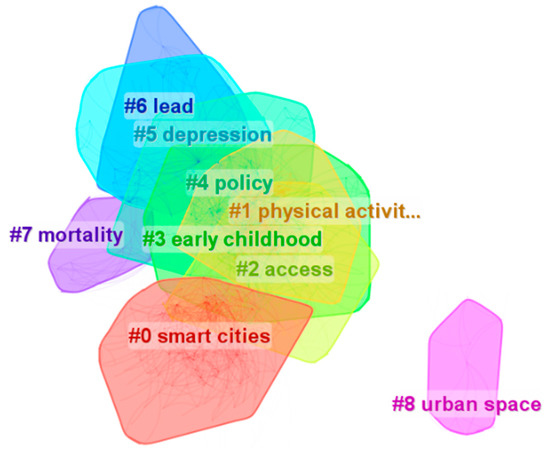
Figure 8.
Cluster map of keywords for urban playability research for the period of 1998–2022.
Cluster #0: The first major cluster relates to the combination of playable cities and smart cities. Keywords include smart city, playable cities, public space and physical activity. The studies focus on the idea of playfulness in urban life, the seamless integration of play into the smart fabric of the city, the ability of citizens to transform infrastructure for personal playful purposes, the interaction with the built environment, etc.
Cluster #1: The second major cluster focuses on the relationship between the built environment and young people’s perceptions of playability. It includes the topics of physical activity, built environment, youth, independent mobility and neighbourhood.
Cluster #2: The third major cluster relates to the attractiveness and playability of urban green spaces. Urban green space is often an important outdoor space that expresses the playability of a city and attracts people of all ages to play. It includes access, intersectionality, networks and urban green space.
Cluster #3: The fourth major cluster focuses on children’s perspectives to inspire under-utilised community spaces. It combines fun, playful learning (a child-centred approach to play) and placemaking to infuse under-utilised community spaces with learning potential. Topics include early childhood, child development, health behaviour, green spaces and health.
Cluster #4: The fifth major cluster is relevant to theoretical research in the discussion of human rights and urban play spaces. Some urban play spaces are seen as sites of socio-ecological change. Human rights equality works via the creation of sustainable and socially just urban spaces. It includes policy, knowledge translation, health communication, children’s health and childhood obesity.
Cluster #5: The sixth major cluster focuses on how exposure to neighbourhood violence can negatively affect children’s well-being, sense of self, control over events in their lives and opportunities to play safely in the community. Topics include depression, cocaine, poverty, behaviour and the built environment.
Cluster #6: the seventh major cluster focuses on the study of infants and young children in the field of biology, including lead, metals, dust, and primary and infant education.
Cluster #7: the eighth major cluster focuses on improving the community environment to prevent childhood injuries, including mortality, community, planning, future high streets and planning.
Cluster #8: The ninth major cluster explores how to make urban spaces more appealing. For example, art galleries can enhance the attraction of educational spaces, integrate new media technologies into the city, etc. It includes urban space, interface, social space, ambient storytelling and locative media.
These clusters provide a broad understanding of the themes of urban spatial playability research. The main research objects include the urban, neighbourhood and community spatial scales. The three macro, meso and micro perspectives can be used to cover the scales of the research objects. The macro-level playability theme focuses on smart city design (cluster #0) and the significance of socio-ecological changes in playable spaces (cluster #4); the meso-level playability theme focuses on the accessibility of urban green spaces (cluster #2); and the micro-level playability theme focuses on improving the playability of the social environment (clusters #1, #3, #5, #6 and #7) and improving the playability of urban spaces (cluster #8).

Table 5.
Nine research clusters identified for the playability of urban space for the period 1998–2022.
Table 5.
Nine research clusters identified for the playability of urban space for the period 1998–2022.
| ID | Size | Silhouette | Year | Label (LLR) | Alternative Labels |
|---|---|---|---|---|---|
| 0 | 123 | 0.662 | 2015 | smart cities | smart city, playable cities, public space, physical activity |
| 1 | 84 | 0.662 | 2012 | physical activity | built environment, youth, independent mobility and neighborhood |
| 2 | 74 | 0.715 | 2013 | access | setting, intersectionality, networks, urban green space |
| 3 | 70 | 0.677 | 2010 | early childhood | child development, health behavior, green space, health |
| 4 | 63 | 0.78 | 2011 | policy | knowledge translation, health communication, child health and childhood obesity |
| 5 | 57 | 0.837 | 2005 | depression | cocaine, poverty, behavior, built environment |
| 6 | 37 | 0.842 | 2004 | lead | metals, dust, elementary education, infant |
| 7 | 21 | 0.896 | 2002 | mortality | community, explanation, future high street, planning |
| 8 | 11 | 0.981 | 2014 | urban space | interface, social space, ambient storytelling and locative media |
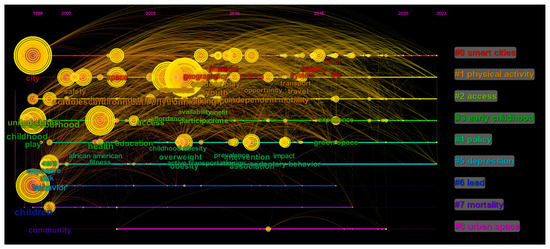
Figure 9.
Cluster time map of keywords for urban playability research during 1998–2022.
3.4. Analysis of Research Phases
Figure 10 presents the map generated of the top 25 keyword prominences. Combining this map with the related literature reveals that the overall research on urban playability is relatively heterogeneous and that the research directions and fields are relatively diverse. From the map we can obtain a general overview of the development of plurality in the research population, referring to the expansion of the research population age range, and the expansion of the research scope, referring to the expansion of the research scale from the community to city levels. Based on the analysis, the research on the overall urban spatial playability from the perspective of social justice can be divided into three stages.
The first phase, which covers 1998–2008, is denoted as “focus on children, the emergence of gender equality”. At the end of the 20th century and the beginning of the 21st century, when cities were growing rapidly, “children” were observed to be excluded from the development of urban public space and gradually marginalised in the field of public space design. The limited cases that considered children involved play spaces that were too private and enclosed [29]. The key words for this stage are inner city, determinant, children, overweight, obesity, prevention, walking and United States, and the studies focus on assessing urban outdoor environments from the perspective of children [30], starting by linking play to physical activity. Children’s education is a key element in this stage, in which play enhances children’s learning, moderately restorative school environments stimulate children’s potential, and children’s exposure to natural elements enhances their understanding, their creativity, their interaction with the world and their benefit from the environment [31]. Children’s health also plays a key role in this stage, in which promoting children’s play reduces childhood obesity rates and improves children’s physical fitness [32]. Several scholars have also reported gender to be an important factor in this field. In order to ensure that public spaces for playing (e.g., parks) are equally attractive to children of different genders, several studies have investigated the relationship between children’s behaviour and the built environment for children of different genders [33].
The second phase, which covers 2008–2016, is denoted as “income equality and the emergence of racial equality”. These studies also included early childhood, adolescence and youth, covering topics such as promoting play and physical activity, as well as considering the influence of social factors on play. The number, type and form of public spaces in cities vary due to the unequal distribution of income and race in urban areas. Additionally, the amount of play required by different ethnic groups does not match social conditions or habits. The key words at this stage are United States, safety, urban planning, urban form, school, opportunity, neighbourhood safety, children’s health, knowledge translation and health communication. William J. Heerman et al. investigated the perceptions of parents in Latino families regarding the characteristics and use of the built environment for their children’s play [34]. Lia Karsten evaluated the living environment of middle-class children in Hong Kong [35]. Ethnic minority youth were reported to be more sedentary than non-minority youth, while changes in youth physical activity were associated with the geography of poverty, income and violent crime. Thus, one hypothesis for racial and ethnic differences is the over-representation of minorities in environments with fewer opportunities for physical activity in safe places.
The third phase, from 2016 to 2022, is denoted as “play as a right, the emergence of age justice”. “Activating public space” becomes an important focus in this phase, in which public space connects people, enables chance encounters in everyday life, provides meaning and power to people’s lives [36], and can be understood as “the experience of interaction between people and places” [37]. This interactive experience is thus considered as a game. This stage introduces the concept of play in public space research; thus, it is no longer the exclusive preserve of children. Scholars explore the playful properties of space in order to activate public space, and playful spatial design is practised at an urban scale. Such playful public spaces act as a ‘tool’ for personal, social and spatial improvement, providing a catalyst for the better use of space, social empowerment and sustainable change. Playful design can create new connections between users and places, facilitating positive experiences in previously under-utilised public spaces. This stage also coincides with the development of the smart cities mantra, the incorporation of smart-city-related technologies into playability research [38] and the expansion of the digital rights of cities. In 2019, cities were affected by the COVID-19 pandemic, which exposed the weaknesses of the existing urban environment in terms of urban space and highlighted the need for the sudden behavioural change in cities [39]. The social distancing that was required between individuals gives rise to socialisation in public spaces. Research on urban playability for the purpose of play is thus a challenge. Although COVID-19 has spread and faded at different rates across the globe, national and regional governments have mainly employed blockades to prevent its spread [40] and have established rules of social distancing that restrict social, commercial and school life. As a result of reliable state regulation, patterns of everyday behaviour have changed, and the range of activities of urban dwellers has been greatly reduced, making them increasingly dependent on the environment around their homes, the natural urban environment and the built urban environment [41]. The multiple effects of these practices have exerted important global implications for mental health, social relations and the economy [42]. The socio-economic impact of the pandemic will diminish as cities adapt to COVID-19, but the changes in people’s attitudes caused by COVID-19 are lasting. Individuals are more committed to living healthy and active lives, and they value the outdoors more than before. There is also a greater demand for open spaces and play areas and an increase in the frequency of active use of more accessible spaces around places of residence. The concentration of larger, better maintained, and higher quality spaces that are used on rest days and holidays has also enhanced. The importance of play thus comes to the foreground.
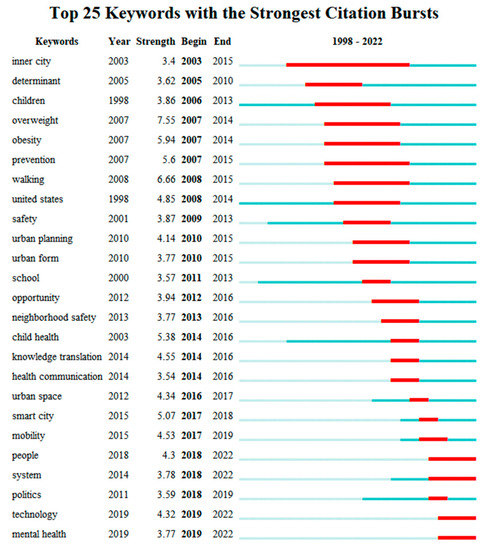
Figure 10.
Top 25 keywords with the strongest citation bursts for the period 1998–2022.
4. Discussion
Previous sections have described the overall development of playability in urban space from multiple perspectives using the analysis of CiteSpace. In order to clarify the direction of playability research in the perspective of social equity, we summarise and discuss the research on playability equity at the micro, meso and macro levels in urban space, via the manual collation of data and the relevant analysis. The potential research on the three topic types of spatial equity in urban spaces at different scales are discussed, as well as the sub-topics of social equity that may be addressed.
4.1. Micro Level
The qualitative equity of spaces is the focus of the study at the micro level. The relationship between the facilities and layout of playable spaces and the equity of the playability needs of different groups is investigated. Playable facilities refer to art, sports and play facilities. The needs of different groups influence the type and layout of facilities and, thus, the equity of playability. The equity of the needs of the people who use them is related to the sub-topics of social equity, including age equity, gender equity and climate and cultural equity.
Age equity refers to the equity of the needs of people at different ages. Playability is often socially perceived as ‘childish’ and was initially used to describe play spaces used primarily by children, without the consideration of the socialisation and play of other age groups. In particular, the inability of playgrounds to allow adults to participate in children’s culture can be considered as another measure of their failure. Play spaces have traditionally been considered as segregated play spaces for protection, which prevents adults from using them. In much of Africa, the literature identifies many urban public spaces as playgrounds for poor children; however, at the same time, young people are disappearing from the streets and being excluded from cities [43]. Elaine Stratford explores how youth skateboarding can gain spatial rights in the city. Ameel et al. examine the role of youth sports, such as parkour, while they investigate the potential of youth sports to ‘relax’ the texture of urban space [44]. J.Fietkau considers older people in the study of playful cities [45].
Gender equity refers to differences in understanding play and the needs of play for women and men and, thus, how play spaces must be designed in a way that is fair to both genders. In particular, Shaiklya et al. determined that unequal social conditions limit young women’s design preferences in public spaces [46]. Asrun et al. investigated the play of poor children in the old city zone of Makassar, Republic of Indonesia and found that boys were more likely to develop spatial skills during social play on their way to school compared to girls [47].
Climate-cultural equity refers to the need for a system of indicators to assess urban playability that meets the needs of different cultural backgrounds in order to achieve equity. The characteristics of playgrounds also vary with the geographical area due to climatic and cultural differences. In cold regions, some slopes, playgrounds, etc., are covered with ice and turned into skating areas, and frozen rivers and lakes are turned into public skating areas—features of public space playability that are not available in non-cold regions. At present, urban playability evaluation indexes generally do not consider the facilities, layout and playability needs of different individuals, despite their importance in enriching urban space playability indexes. At the micro level, climate and culture are often neglected in the playability of urban space research. In particular, different climates and cultures have distinct influences on the facilities and layout, expanding the types and meanings of playability. However, research in this area is lacking. Thus, future work should focus on the relationship between the layout of facilities in playful spaces and the playfulness needs of different individuals, as well as the evaluation indexes of playfulness in urban spaces.
4.2. Meso Level
The spatial and temporal distribution of playable spaces at the community or group level is the key focus of research on spatial distance equity. The study of spatial accessibility has become a hot topic in studies exploring the distance equity of different types of playable spaces. Equity of access has been investigated for public spaces such as urban playgrounds and parks [48] but has not been fully explored under urban playability. Accessibility refers to how easy it is to move from one location to another [49]. Methods such as buffer zone analysis [50], the minimum distance method [51], the gravity model method [52], the two-step movement search method [53] and space syntax [54] have emerged from the process of practical and theoretical research to quantitatively assess the accessibility potential of spaces. Among them, the gravitational model and two-step search methods are widely used to calculate the accessibility of public spaces such as city parks [55]. Accessibility and social equity are inextricably linked. Much research has been conducted on the urban spatial accessibility in the area of urban green spaces and public services [56]. Each type of playable space at the meso level needs to ensure relative equity in a given urban area. Absolute equity refers to the consistency of the accessibility of all types of play spaces in the area, while absolute consistency is no way to bring social equity. The redundancy and waste of play spaces will occur under the guidance of absolute equity planning. Different urban areas have different regional characteristics, and, based on the ratio of regional land use types, the ratio of regional demand characteristics is also different. Relative equity refers to the consistency of playground accessibility characteristics according to regional characteristics. Arroyo-Johnson et al. investigated the safety and proximity of playgrounds, revealing the socio-economic conditions and socio-demographic composition of the area as key influencing factors of the quality and proximity of parks and playgrounds [57]. Hsu et al. employed GIS to understand urban green spaces in the metropolitan areas of Adelaide, Melbourne, Sydney and Brisbane, Australia, dividing the cities into three categories based on population density: inner city, suburban and peri-urban. The authors then calculated metrics to describe the green space accessibility associated with the green space patterns of different metropolitan areas [58]. Thus, developing the evaluation indicators of urban spatial playability from the perspective of accessibility equity is critical for future research.
4.3. Macro Level
The study of urban spatial equity at a macro level focuses on the quantitative equity of space. The main research subtopics are related to both supply and demand equity and economic equity. At the supply and demand equity level, the quantity of supply should meet the overall and regional demand. Numerous scholars in urban and social sciences have employed the Lorenz curve and the Gini coefficient to investigate supply and demand equity. Previous work has calculated the proportion of facility resources based on zones, determined Lorenz curves that measure the distribution of facility resources among the population in each zone and performed cumulative Gini coefficient calculations to determine the equity of supply and demand [59]. At the level of economic equity, it is crucial to examine differences in the spatial distribution and quantity of playability between rich and poor regions. Neckerman et al. found that poor urban areas were less likely to have access to walkable sidewalks, green spaces and safe play areas compared to wealthier urban areas [60]. Cradock et al. determined low-income areas to be further away from safe places within the Boston region compared to wealthier areas [61]. In terms of research methodology, Huang et al. used housing classification data to divide social groups based on urban village, public housing and commercial housing residents. The authors also employed park green vector data and mobile phone SDK-based and location-based population information as supply and demand data sources using a modified Gaussian two-step motion search method to calculate the accessibility of different residential areas to park greens and subsequently determine the regional economic equity. The establishment of evaluation indicators of the fairness of urban spatial playability from the regional equity perspective is, therefore, also a key direction for future research.
5. Conclusions
This paper summarises the definition of playability and the evolution of the definition in detail. Starting from the perspective of social justice, we define the structure of the spatial justice research theme of urban playability under the theme of social justice, namely, a reasonable combination of sub-themes based on social and spatial justice. Social justice subtopics include age, gender, race, culture, etc., while spatial justice research can be divided into quality equity, quantity equity and distance equity. Based on the WOS database, the knowledge map of urban spatial justice research is mapped using Citespace, and the composition of the sub-themes under social justice and the development of spatial justice are analysed in detail. The knowledge map of urban spatial playability research is then mapped, and the composition of the subtopics under social justice and the development of spatial justice are analysed in detail using Citespace. The research progress in this field from 1998 to 2022 is systematically reviewed, and the amount of literature and the number of countries, institutions and author collaborations are sorted. The research hotspots in the field are summarised and the motivations for their emergence are analysed. The three phases of research on playability and social justice in urban spaces are then summarised, namely, “the focus on children, the emergence of gender justice”, “the emergence of income justice and racial justice” and “play as a right, the emergence of age justice”. The research on play in urban spaces from the micro, meso and macro perspectives is subsequently discussed, and the future goals of play equity development are envisaged. These include micro level research on quality equity and age equity, gender equity and climate and cultural equity; meso-level research on the relative equity of accessibility in distance equity; and macro-level research on quantity equity, supply and demand equity and economic equity. The research methods used and the conclusions reached in this paper can promote playability equity within society. In order to meet the needs for playability in urban spaces, more in-depth and comprehensive research should be conducted in the future to promote playability equity and improve the level of playability in urban spaces.
Author Contributions
Conceptualization and methodology, Y.Y. (Yang Ye) and Y.Y. (Yuhan Yang); writing—original draft preparation and editing, Y.Y. (Yang Ye) and Y.Y. (Yuhan Yang); writing—review, Y.Y. (Yang Ye); visualization, Y.Y. (Yuhan Yang); supervision, Y.Y. (Yang Ye). All authors have read and agreed to the published version of the manuscript.
Funding
This research was funded by the National Natural Science Foundation of China, grant number 52008128.
Data Availability Statement
The datasets generated and/or analysed during the current study are available from the corresponding author on reasonable request.
Acknowledgments
The authors value the contributions of all researchers, staff and volunteers that participated in the delivery of the initiative.
Conflicts of Interest
The authors declare no conflict of interest.
References
- Edirisinghe, C.; Nijholt, A.; Cheok, A.D. From Playable to Playful: The Humorous City. In Intelligent Technologies for Interactive Entertainment; Lecture Notes of the Institute for Computer Sciences, Social Informatics and Telecommunications Engineering; Springer: Berlin/Heidelberg, Germany, 2017; pp. 261–265. [Google Scholar]
- Kim, S. Playability for Cities. IOP Conf. Ser. Earth Environ. Sci. 2018, 213, 012002. [Google Scholar] [CrossRef]
- Jacobs, J.M. The Death and Life of Great American Cities; Penguin: Harmondsworth, UK, 1962. [Google Scholar]
- Rivera, M.B.; Ringenson, T.; Pargman, D. The Sustainable Playable City: Making Way for the Playful Citizen. In Making Smart Cities More Playable; Gaming Media and Social Effects; Springer: Berlin/Heidelberg, Germany, 2020; pp. 87–106. [Google Scholar]
- Rawls, J. A Theory of Justice /-Rev. Ed; Oxford University Press: Oxford, UK, 1999. [Google Scholar]
- Xiao, Y.; Wang, Z.; Li, Z.; Tang, Z. An assessment of urban park access in Shanghai—Implications for the social equity in urban China. Landsc. Urban Plan. 2017, 157, 383–393. [Google Scholar] [CrossRef]
- Paavllalnen, J.; Acm. Playability—A Game-Centric Definition. In Proceedings of the 4th ACM SIGCHI Annual Symposium on Computer-Human Interaction in Play (CHI PLAY), Amsterdam, The Netherlands, 15–18 October 2017; pp. 487–494. [Google Scholar]
- Lefebvre, H.; Bas, E.L. Writings on Cities; Wiley-Blackwell: Hoboken, NJ, USA, 1996. [Google Scholar]
- Manzoni, F.S.; Conte, T.U.; Silveira, M.S.; Barbosa, S.D.J. Straight to the Point—Evaluating What Matters for You: A Comparative Study on Playability Heuristic Sets. In Proceedings of the 22nd International Conference on Enterprise Information Systems (ICEIS), Prague, Czech Republic, 5–7 May 2020; pp. 499–510. [Google Scholar]
- Nijholt, A. Playable Cities; Nijholt, A., Puteri, I., Malaysia, J., Eds.; Springer: Singapore, 2017; p. 253. [Google Scholar]
- Bian, Y.; Zhu, W. Improving Playability of Urban Spaces: From KaBOOM! to Playful City USA. Urban Des. 2019, 4, 52–61. [Google Scholar]
- Bridges, C.N.; Prochnow, T.M.; Wilkins, E.C.; Porter, K.M.P.; Meyer, M.R.U. Examining the Implementation of Play Streets: A Systematic Review of the Grey Literature. J. Public Health Manag. Pract. 2020, 26, E1–E10. [Google Scholar] [CrossRef] [PubMed]
- Visser, K.; Aalst, I. Neighbourhood Factors in Children’s Outdoor Play: A Systematic Literature Review. Tijdschr. Voor Econ. Soc. Geogr. 2021, 113, 80–95. [Google Scholar] [CrossRef]
- Adjei-Boadi, D.; Agyei-Mensah, S.; Adamkiewicz, G.; Rodriguez, J.I.; Gemmell, E.; Ezzati, M.; Baumgartner, J.; Owusu, G. Neighbourhood, Built Environment and Children’s Outdoor Play Spaces in Urban Ghana: Review of Policies and Challenges. Landsc. Urban Plan 2022, 218, 104288. [Google Scholar] [CrossRef]
- Pouris, A.; Pouris, A. Scientometrics of a pandemic: HIV/AIDS research in South Africa and the World. Scientometrics 2010, 86, 541–552. [Google Scholar] [CrossRef]
- Yang, J.; Lu, H. Visualizing the Knowledge Domain in Urban Soundscape: A Scientometric Analysis Based on CiteSpace. Int. J. Environ. Res. Public Health 2022, 19, 13912. [Google Scholar] [CrossRef]
- Chen, C.M. CiteSpace II: Detecting and visualizing emerging trends and transient patterns in scientific literature. J. Am. Soc. Inf. Sci. Technol. 2006, 57, 359–377. [Google Scholar] [CrossRef]
- Chen, Y.; Chen, C.M.; Liu, Z.Y.; Hu, Z.G.; Wang, X.W. The methodology function of CiteSpace mapping knowledge domains. Stud. Sci. Sci. 2015, 33, 242–253. [Google Scholar] [CrossRef]
- Tian, Y.; Cheng, W.; Song, H. Global scientific production on GIS research by bibliometric analysis from 1997 to 2006. J. Informetr. 2008, 2, 65–74. [Google Scholar] [CrossRef]
- Wang, H.; He, Q.; Liu, X.; Zhuang, Y.; Song, H. Global urbanization research from 1991 to 2009: A systematic research review. Landsc. Urban Plan. 2012, 104, 299–309. [Google Scholar] [CrossRef]
- Taylor, A.F.; Wiley, A.; Kuo, F.E.; Sullivan, W.C. Growing Up in the Inner City. Environ. Behav. 2016, 30, 3–27. [Google Scholar] [CrossRef]
- Zheng, J.; Hou, M.; Liu, L.; Wang, X. Knowledge Structure and Emerging Trends of Telerehabilitation in Recent 20 Years: A Bibliometric Analysis via CiteSpace. Front. Public Health 2022, 10, 904855. [Google Scholar] [CrossRef] [PubMed]
- Oliver, M.; Witten, K.; Kearns, R.A.; Mavoa, S.; Ergler, C. Kids in the city study: Research design and methodology. BMC Public Health 2011, 11, 587. [Google Scholar] [CrossRef]
- Carroll, P.; Witten, K.; Kearns, R. Housing Intensification in Auckland, New Zealand: Implications for Children and Families. Hous. Stud. 2011, 26, 353–367. [Google Scholar] [CrossRef]
- Tremblay, M.S.; Barnes, J.D.; Gonzalez, S.A.; Katzmarzyk, P.T.; Onywera, V.O.; Reilly, J.J.; Tomkinson, G.R.; the Global Matrix 2.0 Research Team. Global Matrix 2.0: Report Card Grades on the Physical Activity of Children and Youth Comparing 38 Countries. J. Phys. Act. Health 2016, 13, S343–S366. [Google Scholar] [CrossRef]
- Oyeyemi, A.L.; Kasoma, S.S.; Onywera, V.O.; Assah, F.; Adedoyin, R.A.; Conway, T.L.; Moss, S.J.; Ocansey, R.; Kolbe-Alexander, T.L.; Akinroye, K.K.; et al. NEWS for Africa: Adaptation and reliability of a built environment questionnaire for physical activity in seven African countries. Int. J. Behav. Nutr. Phys. Act 2016, 13, 33. [Google Scholar] [CrossRef]
- Huang, J.H.; Hipp, J.A.; Marquet, O.; Alberico, C.; Fry, D.; Mazak, E.; Lovasi, G.S.; Robinson, W.R.; Floyd, M.F. Neighborhood characteristics associated with park use and park-based physical activity among children in low-income diverse neighborhoods in New York City. Prev. Med. 2020, 131, 105948. [Google Scholar] [CrossRef]
- Marquet, O.; Hipp, J.A.; Alberico, C.; Huang, J.-H.; Fry, D.; Mazak, E.; Lovasi, G.S.; Floyd, M.F. Park use preferences and physical activity among ethnic minority children in low-income neighborhoods in New York City. Urban For. Urban Green. 2019, 38, 346–353. [Google Scholar] [CrossRef]
- Karsten, L. Mapping Childhood in Amsterdam: The spatial and social construction of children’s domains in the city. Tijdschr. Econ. Soc. Geogr. 2002, 93, 231–241. [Google Scholar] [CrossRef]
- Jutras, S. Allez jouer dehors! Contributions de l’environnement urbain au développement et au bien-être des enfants. Can. Psychol. 2003, 44, 257–266. [Google Scholar] [CrossRef]
- Mårtensson, F.; Boldemann, C.; Söderström, M.; Blennow, M.; Englund, J.-E.; Grahn, P. Outdoor environmental assessment of attention promoting settings for preschool children. Health Place 2009, 15, 1149–1157. [Google Scholar] [CrossRef] [PubMed]
- Tucker, P.; Gilliland, J.; Irwin, J.D. Splashpads, swings, and shade: Parents’ preferences for neighbourhood parks. Can. J. Public Health 2007, 98, 198–202. [Google Scholar] [CrossRef]
- Karsten, L. Children’s use of public space the gendered world of the playground. Childhood 2003, 10, 457–473. [Google Scholar] [CrossRef]
- Heerman, W.J.; Mitchell, S.J.; Thompson, J.; Martin, N.C.; Sommer, E.C.; van Bakergem, M.; Taylor, J.L.; Buchowski, M.S.; Barkin, S.L. Parental perception of built environment characteristics and built environment use among Latino families: A cross-sectional study. BMC Public Health 2016, 16, 1–8. [Google Scholar] [CrossRef]
- Karsten, L. Middle-class childhood and parenting culture in high-rise Hong Kong: On scheduled lives, the school trap and a new urban idyll. Child. Geogr. 2014, 13, 556–570. [Google Scholar] [CrossRef]
- Carr, S.; Francis, M.; Rivlin, L.; Stome, A. Public Space; Cambridge University Press: Cambridge, UK, 1991. [Google Scholar]
- Lownsbrough, H.; Beunderman, J. Equally Spaced? Public Space and Interaction between Diverse Communities: A Report for the Commission for Racial Equality; Demos: London, UK, 2007. [Google Scholar]
- Nijholt, A. Virtual and Augmented Reality Animals in Smart and Playful Cities: (Invited Paper). In Proceedings of the 2020 Joint 9th International Conference on Informatics, Electronics & Vision (ICIEV) and 2020 4th International Conference on Imaging, Vision & Pattern Recognition (icIVPR), Kitakyushu, Japan, 26–29 August 2020; pp. 1–7. [Google Scholar]
- Cavada, M. Evaluate Space after Covid-19: Smart City Strategies for Gamification. Int. J. Hum. Comput. Interact. 2022, 39, 319–330. [Google Scholar] [CrossRef]
- Gondauri, D.; Mikautadze, E.; Batiashvili, M. Research on COVID-19 Virus Spreading Statistics based on the Examples of the Cases from Different Countries. Electron. J. Gen. Med. 2020, 17, em209. [Google Scholar] [CrossRef]
- Zhang, L.; Han, X.; Wu, J.; Wang, L. Mechanisms influencing the factors of urban built environments and coronavirus disease 2019 at macroscopic and microscopic scales: The role of cities. Front. Public Health 2023, 11, 1137489. [Google Scholar] [CrossRef]
- Gür, M. Post-pandemic lifestyle changes and their interaction with resident behavior in housing and neighborhoods: Bursa, Turkey. J. Hous. Built Environ. 2022, 37, 823–862. [Google Scholar] [CrossRef] [PubMed]
- Blerk, V.; Lorraine. ‘Managing’ Cape Town’s street children/youth: The impact of the 2010 World Cup bid on street life in the city of Cape Town. S. Afr. Geogr. J. 2011, 93, 29–37. [Google Scholar] [CrossRef]
- Ameel, L.; Tani, S. Parkour: Creating loose spaces? Geogr. Ann. Ser. B Hum. Geogr. 2016, 94, 17–30. [Google Scholar] [CrossRef]
- Fietkau, J. The case for including senior citizens in the playable city. In Proceedings of the International Conference on Web Intelligence, Leipzig, Germany, 23–26 August 2017; pp. 1072–1075. [Google Scholar]
- Shaikly, A.; Lira, B.M. Gender-bias in the built environment: How young women’s experiences in public space are understood and addressed in London. J. Urban Des. 2022, 28, 1–20. [Google Scholar] [CrossRef]
- Asrun, A.M.; Said, I.; Rusli, N. Friendliness of route along the home-school journey for less privileged children in old city zone of Makassar. IOP Conf. Ser. Earth Environ. Sci. 2020, 419, 012094. [Google Scholar] [CrossRef]
- Song, Y.; Newman, G.; Huang, X.; Ye, X. Factors influencing long-term city park visitations for mid-sized US cities: A big data study using smartphone user mobility. Sustain. Cities Soc. 2022, 80, 103815. [Google Scholar] [CrossRef]
- Learmonth, A.T.A.; Johnston, R. The Dictionary of Human Geography. Geogr. J. 1983, 149, 103. [Google Scholar] [CrossRef]
- Liao, H. Mapping, evaluation and improvement of open accessible green spaces in central urban districts of Beijing. Mod. Urban 2019, 34, 8. [Google Scholar] [CrossRef]
- Comber, A.; Brunsdon, C.; Green, E. Using a GIS-based network analysis to determine urban greenspace accessibility for different ethnic and religious groups. Landsc. Urban Plan. 2008, 86, 103–114. [Google Scholar] [CrossRef]
- Cai, Y.; Wen, Y.; Cheng, J. Spatial pattern and accessibility of urban park greenland in center of Guangzhou city. Ecol. Environ. Sci. 2011, 20, 1647–1652. [Google Scholar]
- De Tong, Y.S.; Miaomiao, X. Evaluation of green space accessibility based on improved Gaussian two-step floating catchment area method: A case study of Shenzhen City, China. Prog. Geogr. 2021, 40, 1113–1126. [Google Scholar] [CrossRef]
- Jiang, B.; Claramunt, C.; Batty, M. Geometric accessibility and geographic information: Extending desktop GIS to space syntax. Comput. Environ. Urban Syst. 1999, 127–146. [Google Scholar] [CrossRef]
- Huang, J.; Lin, J.; Tao, Z.; Yang, J. Evaluation of park green space accessibility in Shenzhen from the perspective of social equity. Sci. Geogr. Sin. 2022, 42, 896–906. [Google Scholar] [CrossRef]
- Fernandez, J.; Song, Y.; Padua, M.; Liu, P. A Framework for Urban Parks: Using Social Media Data to Assess Bryant Park, New York. Landsc. J. 2022, 41, 15–29. [Google Scholar] [CrossRef]
- Arroyo-Johnson, C.; Woodward, K.; Milam, L.; Ackermann, N.; Komaie, G.; Goodman, M.S.; Hipp, J.A. Still Separate, Still Unequal: Social Determinants of Playground Safety and Proximity Disparities in St. Louis. J. Urban Health Bull. N. Y. Acad. Med. 2016, 93, 627–638. [Google Scholar] [CrossRef]
- Hsu, Y.-Y.; Hawken, S.; Sepasgozar, S.; Lin, Z.-H. Beyond the Backyard: GIS Analysis of Public Green Space Accessibility in Australian Metropolitan Areas. Sustainability 2022, 14, 4694. [Google Scholar] [CrossRef]
- Delbosc, A.; Currie, G. Using Lorenz curves to assess public transport equity. J. Transp. Geogr. 2011, 19, 1252–1259. [Google Scholar] [CrossRef]
- Neckerman, K.M.; Lovasi, G.S.; Davies, S.; Purciel, M.; Quinn, J.; Feder, E.; Raghunath, N.; Wasserman, B.; Rundle, A. Disparities in Urban Neighborhood Conditions: Evidence from GIS Measures and Field Observation in New York City. J. Public Health Policy 2009, 30, S264–S285. [Google Scholar] [CrossRef] [PubMed]
- Cradock, A.L.; Kawachi, I.; Colditz, G.A.; Hannon, C.; Melly, S.J.; Wiecha, J.L.; Gortmaker, S.L. Playground safety and access in Boston neighborhoods. Am. J. Prev. Med. 2005, 28, 357–363. [Google Scholar] [CrossRef] [PubMed]
Disclaimer/Publisher’s Note: The statements, opinions and data contained in all publications are solely those of the individual author(s) and contributor(s) and not of MDPI and/or the editor(s). MDPI and/or the editor(s) disclaim responsibility for any injury to people or property resulting from any ideas, methods, instructions or products referred to in the content. |
© 2023 by the authors. Licensee MDPI, Basel, Switzerland. This article is an open access article distributed under the terms and conditions of the Creative Commons Attribution (CC BY) license (https://creativecommons.org/licenses/by/4.0/).